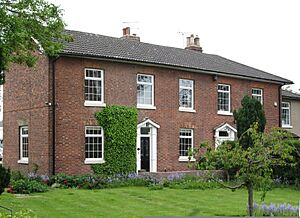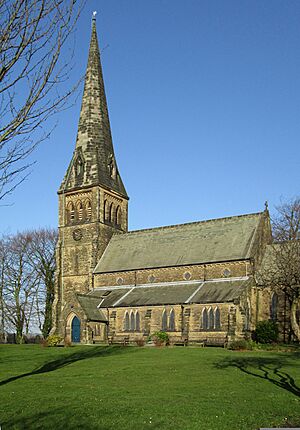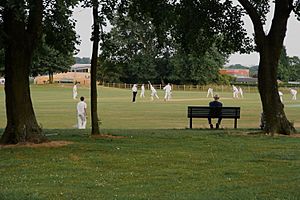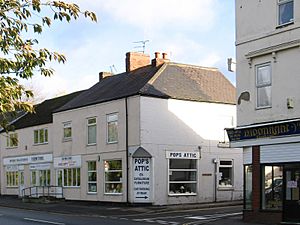Clay Cross facts for kids
Quick facts for kids Clay Cross |
|
|---|---|
 Clocktower and adult education centre |
|
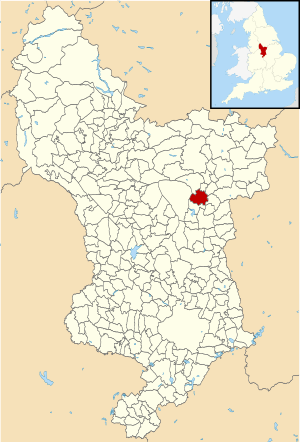 Clay Cross parish highlighted within Derbyshire |
|
| Population | 9,222 (civil parish, 2011) |
| OS grid reference | SK392631 |
| Civil parish |
|
| District |
|
| Shire county | |
| Region | |
| Country | England |
| Sovereign state | United Kingdom |
| Post town | CHESTERFIELD |
| Postcode district | S45 |
| Dialling code | 01246 |
| Police | Derbyshire |
| Fire | Derbyshire |
| Ambulance | East Midlands |
| EU Parliament | East Midlands |
| UK Parliament |
|
Clay Cross is a town in Derbyshire, England. It is about 5 miles (8 km) south of Chesterfield. The town is located right on the A61 main road.
Nearby places include North Wingfield, Tupton, Pilsley, and Ashover. Clay Cross used to be a big industrial and mining town.
Contents
History of Clay Cross
The main street in Clay Cross was built over an old Roman road. This road might have been called Rykneild Street.
In the early 1800s, Clay Cross was a small village called Clay Lane. But then, coal was found nearby. This discovery changed the village a lot.
Packhorses first carried coal over the hills. They used a special turnpike road. This road opened in 1756. It connected iron factories in Derby and Sheffield.
The demand for coal and other minerals grew fast. By 1840, the number of people living in Clay Cross had tripled. The oldest building still standing is the George and Dragon Inn.
George Stephenson and the Railway
While building a tunnel for the North Midland Railway, George Stephenson found a lot of coal and iron. He also found limestone. This made him decide to start a business.
Stephenson moved to Tapton Hall near Chesterfield. He set up a company called George Stephenson and Co.
A map from 1833 showed Thanet Street and Clay Lane. The railway building boom in the 1840s helped the town grow north. This was possible because of the Clay Cross Tunnel. It was dug between 1837 and 1838.
Workers found huge amounts of good quality coal while digging the tunnel. Clay Cross quickly became a very busy town.
The Clay Cross Company
In 1839, Stephenson's engineers formed the Clay Cross Company. They used their own money to start it. The company dug many coal mines. They also built coke ovens, brickworks, and iron factories.
The company became famous worldwide for its iron and coal. They made a special type of pipe that was sold everywhere.
When George Stephenson died in 1848, his son Robert took over. In 1852, the company officially became the Clay Cross Company. The Jackson family owned it from 1871 until 1974.
For many years, this company was the biggest employer in Clay Cross. In 1985, a company called Biwater bought it. Then, in 2000, a French company bought the site. It closed down a few months later. About 750 people lost their jobs.
New houses and shops are now being built where the old Biwater site used to be.
Ashover Light Railway
In 1925, the Ashover Light Railway opened. It was used to carry minerals from quarries to the Clay Cross Company. Passenger services on this small railway stopped in 1936. The mineral transport ended in 1950.
Buildings from the Industrial Era
In 1840, the Stephensons built Eldon House. It was first used as the company's main office. Later, it became a private home.
The Stephensons also built over 400 homes for miners. These homes were very good for their time. They had four rooms, which was more than the usual two.
They also started schools and built new churches. The company even provided gas and electricity for the town.
The biggest house, Clay Cross Hall, was built in 1845. It was for the company's General Manager, Charles Binns.
By 1850, Clay Cross had three chapels, a church, and an institute. One chapel, the Wesleyan Chapel, was built in 1847. It was used until at least 1900.
The company also provided a bowling green with a clubhouse. A Mechanics Institute was opened. This was given to the local school board in 1893. The board's Senior School for Boys opened in 1884. It became a junior school in the 1930s and is still teaching today.
Later, in the Victorian era, middle-class houses were built in a new part of town.
Colliery owner Thomas Houldsworth built Alma House. It stood in large parklands. He was in charge of the Clay Cross pits until 1850. Then he developed the Alma Colliery.
Springfield House was built by the Clay Cross Company. It was for engineer William Howe. He lived there from 1866 until he died in 1872.
Even earlier, Hill House was built by 1833. The North Midland Railway Company bought it in 1837. It was an office for their engineer, Frederick Swanwick.
When the tunnel was finished, Swanwick left. But the house was used by other engineers. Later, a local doctor lived there.
The North Midland Railway tunnel had nine vents. Smoke from the trains would come out of these vents. Clay Cross is the highest point on the railway line. It is 361 feet (110 meters) above sea level.
A small railway line carried coal up to the works. The Clay Cross railway station was a mile north. It was between the stops at Tupton and Hepthorne Lane.
Religion in Clay Cross
The Anglican church of St Bartholomew was built in 1851. A spire was added six years later.
The first church leaders were Rev. Joseph Oldham and his wife, Emma. Emma's brother was William Morris. He was a famous designer. Morris made a beautiful stained glass window for the church.
Other places of worship in Clay Cross are:
- Methodist Church on High Street.
- Clay Cross Community Church - C4 (Assemblies of God) on Market Street.
- Roman Catholic Church of St. Patrick and St. Bridget on Thanet Street.
- Holmgate Evangelical Church on Valley Road, Holmgate.
- Salvation Army on Thanet Street.
- St Barnabas Church in Danesmoor.
- Community of Christ on Thanet Street.
Danesmoor Cemetery and Parkhouse Memorial
The Parkhouse Colliery Memorial is in Danesmoor Cemetery. It remembers a sad event. In November 1882, an explosion happened underground. The mine shaft collapsed. This caused the death of 45 men and boys. Many of their families lived in company houses nearby.
Local Government and a Famous Dispute
Clay Cross was a special local area called an urban district until 1974. Then it became part of the North East Derbyshire district.
In the 1970s, the local council became well-known. They refused to follow a new law called the Housing Finance Act 1972. This law said that rents for council housing should go up by £1 a week.
The Clay Cross council was one of a few that said no to this law. The government ordered them to follow the law. In January 1973, the eleven Labour Party councillors were ordered to pay a fine. They were found "guilty of negligence and misconduct."
The councillors tried to fight this decision in court. But the court upheld the fine. They also had to pay more money for legal costs. The councillors were also not allowed to hold public office for five years.
The dispute ended when the Clay Cross Urban District Council was replaced. This happened on April 1, 1974. The councillors went bankrupt in 1975.
A book about this dispute was written by one of the councillors, David Skinner. It was called The Story of Clay Cross.
Local Economy and Transport
Clay Cross has a big, modern business park. It is called Coney Green Business Park.
There is a community hospital on Market Street. The town's library is on Holmgate Road.
The town centre of Clay Cross is being redeveloped. This project costs £22 million. So far, a new supermarket, bus station, and relief road have been built. The next part will include new shops and a medical centre.
The M1 motorway junction 29 is five miles away. The closest train stations are Chesterfield (6 miles) and Alfreton.
The Clay Cross railway station closed in 1967. In 2017, a bus service started. It connects Clay Cross to Chesterfield railway station. A passenger train line still runs under the town in a tunnel, but it does not stop there.
There have been talks about building a new road to help with traffic. The A61 road is very busy. A new dual carriageway might bypass Clay Cross and Tupton.
Education
Tupton Hall School is about one mile north of Clay Cross. It is a large school with around 2,000 students.
Clay Cross used to have a secondary school on Market Street. It also had a junior school off High Street. The junior and infant schools joined together. They moved to a new building on Pilsley Road in Danesmoor. It is now called Sharley Park Community Primary School.
The old secondary school closed in 1969. Students moved to Tupton Hall. The old secondary school building is now an adult education centre.
Media
Local TV news for Clay Cross comes from BBC Yorkshire and ITV Yorkshire. These signals come from the Emley Moor TV transmitter. You can also get signals from BBC East Midlands and ITV Central.
The town is served by BBC Radio Sheffield and BBC Radio Derby. Other radio stations include Greatest Hits Radio North Derbyshire and Chesterfield Radio.
The Derbyshire Times is the local newspaper. It comes out every week.
Sport
Leisure Centre
Sharley Park Leisure Centre is on Market Street. It has swimming, a gym, and sports hall facilities.
Football
Five football clubs from Clay Cross used to play in the FA Cup. They are no longer active:
- Clay Cross Town F.C. (1874)
- Clay Cross Zingari F.C.
- Clay Cross Town F.C. (1909)
- Clay Cross & Danesmoor Welfare F.C.
- Biwater F.C. (also known as Clay Cross Works F.C.)
The town's current team is called Clay Cross Town. They play in the Central Midlands Football League. They first played in the FA Vase in 2016.
Population
In the 2011 census, most people in Clay Cross were White (97.7%). A smaller number were Asian (1.1%), Mixed (0.8%), and Black (0.2%).
Notable Residents
- Reg Gore (1913–1996), a professional footballer.
- Arthur Henderson, who won the Nobel Peace Prize in 1934. He was a Member of Parliament (MP) for Clay Cross. He was also the leader of the Labour Party three times.
- Sir George Kenning (1880–1956) was a successful businessman from Derbyshire. He started with a small hardware shop in Clay Cross. His business grew into a big car dealership across the country. Sir George was very active in public life. He served on the local council and the county council. He also gave a recreation ground to the people of Clay Cross. It is called "Kenning Park." He was knighted in 1943 for his public service.
- Eddie Shimwell, an FA Cup winner.
- Dennis Skinner was born and grew up in Clay Cross. He worked at Parkhouse Colliery, a coal mine, starting in 1949. He was a Clay Cross councillor from 1960 to 1970. Then he became an MP in 1970.
See also
 In Spanish: Clay Cross para niños
In Spanish: Clay Cross para niños


